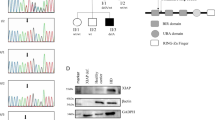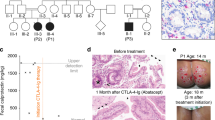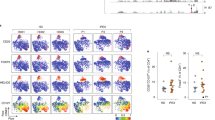Abstract
The homeostasis of the immune response requires tight regulation of the proliferation and apoptosis of activated lymphocytes1,2. In humans, defects in immune homeostasis result in lymphoproliferation disorders including autoimmunity, haemophagocytic lymphohystiocytosis and lymphomas. The X-linked lymphoproliferative syndrome (XLP) is a rare, inherited immunodeficiency that is characterized by lymphohystiocytosis, hypogammaglobulinaemia and lymphomas, and that usually develops in response to infection with Epstein–Barr virus (EBV)3,4,5. Mutations in the signalling lymphocyte activation molecule (SLAM)-associated protein SAP, a signalling adaptor molecule, underlie 60% of cases of familial XLP6,7,8. Here, we identify mutations in the gene that encodes the X-linked inhibitor-of-apoptosis XIAP (also termed BIRC4) in patients with XLP from three families without mutations in SAP. These mutations lead to defective expression of XIAP. We show that apoptosis of lymphocytes from XIAP-deficient patients is enhanced in response to various stimuli including the T-cell antigen receptor (TCR)–CD3 complex, the death receptor CD95 (also termed Fas or Apo-1) and the TNF-associated apoptosis-inducing ligand receptor (TRAIL-R). We also found that XIAP-deficient patients, like SAP-deficient patients, have low numbers of natural killer T-lymphocytes (NKT cells)9,10, indicating that XIAP is required for the survival and/or differentiation of NKT cells. The observation that XIAP-deficiency and SAP-deficiency are both associated with a defect in NKT cells strengthens the hypothesis that NKT cells have a key role in the immune response to EBV. Furthermore, by identifying an XLP immunodeficiency that is caused by mutations in XIAP, we show that XIAP is a potent regulator of lymphocyte homeostasis in vivo.
This is a preview of subscription content, access via your institution
Access options
Subscribe to this journal
Receive 51 print issues and online access
$199.00 per year
only $3.90 per issue
Buy this article
- Purchase on Springer Link
- Instant access to full article PDF
Prices may be subject to local taxes which are calculated during checkout



Similar content being viewed by others
References
de Saint Basile, G. & Fischer, A. Defective cytotoxic granule-mediated cell death pathway impairs T lymphocyte homeostasis. Curr. Opin. Rheumatol. 15, 436–445 (2003)
Rathmell, J. C. & Thompson, C. B. Pathways of apoptosis in lymphocyte development, homeostasis, and disease. Cell 109, (Suppl.)S97–107 (2002)
Purtilo, D. T., Cassel, C. K., Yang, J. P. & Harper, R. X-linked recessive progressive combined variable immunodeficiency (Duncan's disease). Lancet 1, 935–940 (1975)
Nichols, K. E., Ma, C. S., Cannons, J. L., Schwartzberg, P. L. & Tangye, S. G. Molecular and cellular pathogenesis of X-linked lymphoproliferative disease. Immunol. Rev. 203, 180–199 (2005)
Gaspar, H. B., Sharifi, R., Gilmour, K. C. & Thrasher, A. J. X-linked lymphoproliferative disease: clinical, diagnostic and molecular perspective. Br. J. Haematol. 119, 585–595 (2002)
Nichols, K. E. et al. Inactivating mutations in an SH2 domain-encoding gene in X-linked lymphoproliferative syndrome. Proc. Natl Acad. Sci. USA 95, 13765–13770 (1998)
Sayos, J. et al. The X-linked lymphoproliferative-disease gene product SAP regulates signals induced through the co-receptor SLAM. Nature 395, 462–469 (1998)
Coffey, A. J. et al. Host response to EBV infection in X-linked lymphoproliferative disease results from mutations in an SH2-domain encoding gene. Nature Genet. 20, 129–135 (1998)
Nichols, K. E. et al. Regulation of NKT cell development by SAP, the protein defective in XLP. Nature Med. 11, 340–345 (2005)
Pasquier, B. et al. Defective NKT cell development in mice and humans lacking the adapter SAP, the X-linked lymphoproliferative syndrome gene product. J. Exp. Med. 201, 695–701 (2005)
Salvesen, G. S. & Duckett, C. S. IAP proteins: blocking the road to death's door. Nature Rev. Mol. Cell Biol. 3, 401–410 (2002)
Vaux, D. L. & Silke, J. IAPs, RINGs and ubiquitylation. Nature Rev. Mol. Cell Biol. 6, 287–297 (2005)
Parolini, S. et al. X-linked lymphoproliferative disease. 2B4 molecules displaying inhibitory rather than activating function are responsible for the inability of natural killer cells to kill Epstein-Barr virus-infected cells. J. Exp. Med. 192, 337–346 (2000)
Taniguchi, M., Harada, M., Kojo, S., Nakayama, T. & Wakao, H. The regulatory role of Vα14 NKT cells in innate and acquired immune response. Annu. Rev. Immunol. 21, 483–513 (2003)
Rieux-Laucat, F., Fischer, A. & Deist, F. L. Cell-death signaling and human disease. Curr. Opin. Immunol. 15, 325–331 (2003)
Lenardo, M. et al. Mature T lymphocyte apoptosis–immune regulation in a dynamic and unpredictable antigenic environment. Annu. Rev. Immunol. 17, 221–253 (1999)
Harlin, H., Reffey, S. B., Duckett, C. S., Lindsten, T. & Thompson, C. B. Characterization of XIAP-deficient mice. Mol. Cell. Biol. 21, 3604–3608 (2001)
Wasem, C. et al. Sensitizing antigen-specific CD8+ T cells for accelerated suicide causes immune incompetence. J. Clin. Invest. 111, 1191–1199 (2003)
Schimmer, A. D., Dalili, S., Batey, R. A. & Riedl, S. J. Targeting XIAP for the treatment of malignancy. Cell Death Differ. 13, 179–188 (2006)
Strauss, G., Knape, I., Melzner, I. & Debatin, K. M. Constitutive caspase activation and impaired death-inducing signaling complex formation in CD95-resistant, long-term activated, antigen-specific T cells. J. Immunol. 171, 1172–1182 (2003)
Zennou, V. et al. HIV-1 genome nuclear import is mediated by a central DNA flap. Cell 101, 173–185 (2000)
Acknowledgements
We thank the patients and their families that participated in this study, E. Le Gall (Centre Hospitalier Universitaire de Rennes) and M. Hamidou (Centre Hospitalier Universitaire de Nantes) for the blood samples and their contribution to the follow up of patients from family 1 and 3; A. Veillette and C. Picard for discussions and critical reading of the manuscript; and P. Charneau, M. Bonneville and M. Leite-de-Moraes for their gift of reagents. We also acknowledge the contribution of C. Charon from the Centre National de Génotypage (CNG, Evry, France). This work was supported by grants from the Institut National de la Santé et de la Recherche Médicale (France), the Agence National de la Recherche (France), the Association pour la Recherche contre le Cancer (France), GIS-Institut des Maladies Rares (France) and La Ligue contre le Cancer (France). B.P. was supported by a fellowship from La Ligue contre le Cancer and V.M. by a European Molecular Biology Organization fellowship. S.L. and P.R. are scientists from the Centre National pour la Recherche Scientifique (France).
Author information
Authors and Affiliations
Corresponding author
Ethics declarations
Competing interests
Reprints and permissions information is available at www.nature.com/reprints. The authors declare no competing financial interests.
Supplementary information
Supplementary Notes 1
This file contains the Supplementary Table 1 and the Supplementary Figures and Legends 1–7. (PPT 1315 kb)
Supplementary Notes 2
This file contains the detailed Supplementary Methods and additional references and statistical values of Figures 2b and 3a–c. (DOC 32 kb)
Rights and permissions
About this article
Cite this article
Rigaud, S., Fondanèche, MC., Lambert, N. et al. XIAP deficiency in humans causes an X-linked lymphoproliferative syndrome. Nature 444, 110–114 (2006). https://doi.org/10.1038/nature05257
Received:
Accepted:
Issue Date:
DOI: https://doi.org/10.1038/nature05257
This article is cited by
-
Understanding the molecular mechanism of pathogenic variants of BIR2 domain in XIAP-deficient inflammatory bowel disease
Scientific Reports (2024)
-
Novel XIAP mutation with early-onset Crohn’s disease complicated with acute heart failure: a case report
BMC Cardiovascular Disorders (2023)
-
XIAP deletion sensitizes mice to TNF-induced and RIP1-mediated death
Cell Death & Disease (2023)
-
Beyond IBD: the genetics of other early-onset diarrhoeal disorders
Human Genetics (2023)
-
Lentiviral Gene Transfer Corrects Immune Abnormalities in XIAP Deficiency
Journal of Clinical Immunology (2023)
Comments
By submitting a comment you agree to abide by our Terms and Community Guidelines. If you find something abusive or that does not comply with our terms or guidelines please flag it as inappropriate.



